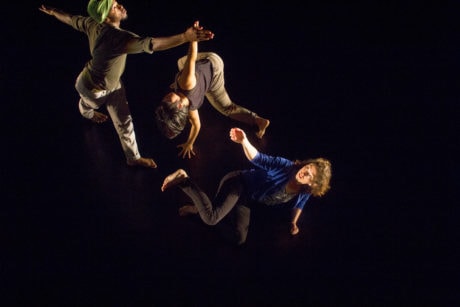Lucky Plush Productions is a dance/theater company currently performing at the Kennedy Center’s Terrace Theater. But this is no conventional company. Compared to dance troupes, they are at the opposite end of the performance spectrum from Martha Graham or Merce Cunningham: they don’t simply tell stories accompanied by music. They talk as much as they dance. Watching them is like watching Twyla Tharp or Jerome Robbins talk to their dancers about an upcoming work, or watching a group of clowns trying to decide how best to entertain an audience: shall we give them Show A or Show B? What should Show C consist of?

Fortunately, the dancers in Lucky Plush are interesting characters and their talk is generally entertaining, even if they are only planning the next dance, not yet doing it. And in between the talk, they break into dance and the observer can remember the transformative beauty of dance, whether it is done by one person, two people, four people, or six.
Based in Chicago, Lucky Plush has won many awards, among them the famous MacArthur Award for Creative and Effective Institutions. Led by its founder and Artistic Director Julia Rhoads, Lucky Plush has created thirty-plus original dance/theater works since 2000. The company has presented work in over fifty-five United States cities from Maine to Hawaii, and its international partners include groups in New Zealand and Cuba.
Rooming House begins with six dancers chatting about an incident that happened to the family of one of them. Then the talk shifts to the myth that will be the basis of the dance they are planning: the story of Orpheus and Eurydice. In Greek mythology, Eurydice was a daughter of Zeus, married to Orpheus, son of Apollo and a brilliant musician. When Eurydice was in a field one day, a snake bit her. She died and was taken to the Underworld. Orpheus was heartbroken.
Apollo intervened to allow Orpheus to descend to the Underworld, retrieve Eurydice and bring her back to the world of the living. There was just one caveat: Orpheus could not look back at his wife until they were all the way home, out of the Underworld. Sadly, just before they reached the land of the living, Orpheus turned to look at his wife.
As the dancers try to dissect the myth, they realize that they need more information about each of the characters. They need to determine what is really going on in the myth. They decide to give each character a backstory. Then they need to figure out what the main action is and why Orpheus looked back? Was he unfaithful to begin with?

Ultimately, creating this story involves telling the stories of the dancers themselves. One, for instance, Rodolfo Sánchez Sarracino, is originally from Cuba. The dancers question him and want to know all about his travels from Cuba to America. The audience learns that the only thing Rodolfo feared was that he would never see his mother again, because she had kidney disease. This is a very moving part of the show and Co-Creators Rhoads and Leslie Buxbaum Danzig (who also direct) wisely use the theme of loss of family again and again, bringing it back perhaps to underscore the relevance of Orpheus’ loss of Eurydice.
Costume design by Patrick Burns includes jeans and multicolored shirts for both men and women. Original synthesizer music created by Michael Caskey accompanies this show. At times, it is just drums. Sometimes, especially when Sarracino is dancing, it is a Latin sounding beat. At one point, when the brilliant dancer A. Rahiem White creates a hip-hop song, the music changes to accompany him.
Like the music, the lighting seems to follow the dancers. As they put together their dance, they create different areas to create in: the Event Room; the Break Room, etc. Lighting Designer Alexander Ridgers creates these “rooms” for them with square spotlights.
Ultimately, Lucky Plush is a delight to watch, for many reasons: its sense of humor, its unconventional storytelling, its plucky choreography (by Rhoads), and the way it reveals what goes into making a dance. Most of all, the basis of its charm is that it comes across as being a small family, even more than a dance company.
Running Time: 75 minutes, with no intermission.
Rooming House, presented by Lucky Plush Productions, performs through May 4, 2019, at The Kennedy Center Terrace Theater, 2700 F Street, NW, Washington, DC. For tickets, call 202-467-4600 or 800-444-1324, or go online.
Also dancing in this production: Kara Brody, Elizabeth Luse, Michel Rodriguez Cintra, Meghann Rose Wilkinson




